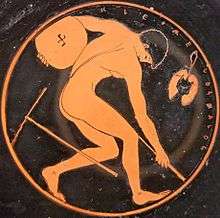Halteres (ancient Greece)
- This article concerns an ancient sports object. For halteres in insect anatomy, see Halteres.
Halteres (Greek: ἁλτῆρες,[1] from "ἅλλομαι" - hallomai, "leap, spring";[2] cf. "ἅλμα" - halma, "leaping"[3]) were a type of dumbbells used in Ancient Greece. In ancient Greek sports, halteres were used as lifting weights,[4][5] and also as weights in their version of the long jump,[6] which was probably a set of three jumps. Halteres were held in both hands to allow an athlete to jump a greater distance; they may have been dropped after the first or second jump. According to archaeological evidence, the athlete would swing the weights backwards and forwards just before take-off, thrust them forwards during take-off, and swing them backwards just before releasing them and landing. Halteres were made of stone or metal, and weighed between 12 and 35 kg (26 and 77 lb).
Writing in Nature, biophysicist Alberto E. Minetti calculates that halteres added about 17 cm (7 in) to a 3 m (10 ft) long jump.[7]
-

Athlete holding halteres. Ancient Greek Attic black-figure lekythos, 525–500 BC, from Sicily. Staatliche Antikensammlungen, Munich.
-

Young boy holding a discus at the palaestra. Near him, a pick to prepare the landing ground for the long jump and a pair of halteres used to maintain equilibrium during the jump. Interior of an Ancient Greek Attic red-figure kylix, 510–500 BC, Louvre Museum, Paris.
-

Long jumper with halteres. red-figure kylix, ca. 510 BC. Ancient Agora Museum, Athens.
References
- ↑ ἁλτῆρες, Henry George Liddell, Robert Scott, A Greek-English Lexicon, on Perseus Digital Library
- ↑ ἅλλομαι, Henry George Liddell, Robert Scott, A Greek-English Lexicon, on Perseus Digital Library
- ↑ ἅλμα, Henry George Liddell, Robert Scott, A Greek-English Lexicon, on Perseus Digital Library
- ↑ Norman Gardiner, Athletics in the Ancient World, Dover, 2002, on Google books
- ↑ Bill Pearl, Getting Stronger: Weight Training for Sports, Shelter, 2005, on Google books
- ↑ Stephen G. Miller, Ancient Greek Athletics, Yale University Press, 2006, on Google books
- ↑ Minetti, Alberto E (14 November 2002). "Biomechanics: Halteres used in ancient Olympic long jump". Nature. 420: 141–142. doi:10.1038/420141a.